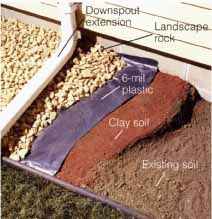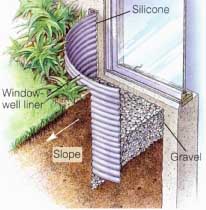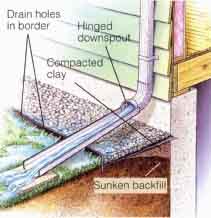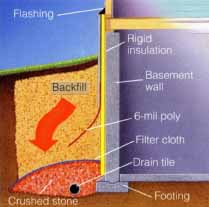The first strategy for drying a damp or wet basement is to channel water from rain or melting snow away from the foundation. Most solutions are low-tech and inexpensive, and you can quickly spot failures and correct them. Approach the problem by beginning at the top -- the gutters.
To keep gutters clean, simplify maintenance by installing gutter guards and larger downspouts. Check the pitch of your gutters to ensure they slope toward the downspout (standing water is a giveaway that they don’t slope enough). For sagging gutters, replace or reattach any loose fasteners. With the gutters in good repair, look at the surrounding landscape for problems.
When a patio, driveway or sidewalk running along the house settles and tilts toward the house, it directs water toward the basement wall instead of away from it. In these cases, the best solution is to break out the tilted concrete, regrade the compacted soil and pour a new slab.
Sloping Soil Around Foundation

The soil around a house should slope away from the foundation at about 1 in. per foot (2.5 cm per 30 cm) for the first 10 ft. (3 m). Unfortunately, drainage problems are often caused by backfill around the foundation that has sunk over the years. To solve small slope issues, firmly pack clay soil around the foundation at a slope. Cover the clay soil with 6-mil black plastic and cover the plastic with landscape rock. For large problems, you may need to consider regrading and landscaping.
Improving Window Wells

Window wells are a vulnerable spot because they’re essentially temporary catch basins for surface runoff and saturated soil. Plastic well covers help some what, but a better solution is to keep the well itself in good shape. To do that, extend the window well soil retainer above ground level, seal the edges with silicone and dig the bottom out 12 in. (30 cm) below the sill. Finally, fill the well with stone to make a temporary drainage basin.
Extending Downspouts

Missing or short downspout extensions, in conjunction with poor landscape drainage, can lead to basement moisture. First, correct slope problems, and then add a longer downspout extension. If you have a plastic border, drill holes in it, or use a perforated border to provide drainage. For convenience, use a hinged extension that can be swung out of the way when you mow the lawn.
Installing Exterior Drainage

Exterior drainage, while more expensive than interior drainage, usually has the advantage of not requiring electricity (for a sump pump) to work, and you don’t have to tear up the basement floor. With this repair, you prevent water from get ting to the foundation by using the correct type of fill gravel around the foundation and footings. Filter cloth keeps the gravel clean, and drain tile carries the water away (sometimes to an interior sump pump). Rigid insulation and plastic sheeting help prevent seepage problems.